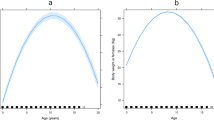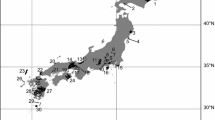Abstract
Growth patterns were examined using age-weight data from 21 264 white-tailed deer (Odocoileus virginianus) collected over a 22-year period on the Savannah River Site, located near Aiken, South Carolina, USA. The Richards growth equation was used to evaluate the effects of sex, habitat, and genetic variation on asymptotic weight and the length of the growth period. Male deer grew for a longer period of time and obtained greater adult weights than did females. This variation in growth patterns is probably due to differences in life history strategies of the two sexes. Contrary to previous investigations, no associations were detected between genotypic variation at nine electrophoretic loci, or overall heterozygosity, and growth patterns of deer. Growth patterns of deer from upland habitat were different than those of deer from an adjacent swamp. Both sexes tended to grow faster and attain greater body weights in the uplands than in the swamp; however, asymptotic weight of males was the only growth parameter that differed significantly between the habitat types. Differences in growth functions among habitats may be related to differences in density, habitat quality, or the genetic composition of the populations. These results suggest that patterns of growth, which can affect levels of productivity of cervid populations, can differ significantly over relatively small geographic areas.
Access this chapter
Tax calculation will be finalised at checkout
Purchases are for personal use only
Preview
Unable to display preview. Download preview PDF.
Similar content being viewed by others
References
Brisbin IL Jr, Lenarz MS (1984) Morphological comparisons of insular and mainland populations of southeastern white-tailed deer. J Mammal 65: 44 – 50
Brisbin IL Jr, White GC, Bush PB (1986) PCB intake and the growth of waterfowl: multivariate analyses based on a reparameterized Richard’s sigmoid model. Growth 50: 1 – 11
Chesser RH, Smith MH (1987) Relationship of genetic variation to growth and reproduction in white- tailed deer. In Wemmer CM (ed) Biology and Management of the Cervidae. Smithsonian Institution Press, Washington, D.C., pp 168 – 177
Clutton-Brock TH, Guiness FE, Albon SA (1982) Red Deer. Behavior and Ecology of Two Sexes. University of Chicago Press, Chicago
Cook RS, White M, Trainer DO, Glazener WC (1971) Mortality of young white-tailed deer fawns in south Texas. J Wildlife Management 35: 47 – 56
Cothran EG, Chesser RK, Smith MH, Johns PE (1983) Influences of genetic variability and maternal factors on fetal growth in white-tailed deer. Evolution 37: 282 – 291
Dapson RW, Ramsey PR, Smith MH, Urbston DF (1979) Demographic differences in contiguous populations of white-tailed deer. J Wildlife Management 43: 889 – 898
Falconer DS (1960) Introduction to quantitative genetics. Ronald Press, New York
Fuller TK, Pace RM III, Markl J A, Coy PL (1989) Morphometries of white-tailed deer in north-central Minnesota. J Mammal 70: 184 – 188
Hirth DH (1977) Social Behavior of White-Tailed Deer in Relation to Habitat. Wildl Monogr No 41. Wildlife Society, Washington D.C.
Johns PE, Baccus R, Manlove MN, Pinder JE III, Smith MH (1977) Reproductive patterns, productivity, and genetic variability in adjacent white- tailed deer populations. Proc Southeastern Assoc Fish Wildl Agencies 31: 167 – 172
Johns PE, Baccus R, Manlove MN, Pinder JE III, Smith MH (1977) Reproductive patterns, productivity, and genetic variability in adjacent white- tailed deer populations. Proc Southeastern Assoc Fish Wildl Agencies 31: 167 – 172
Leberg PL, Smith MH, Rhodes OE Jr (1990) The association between heterozygosity and the growth of deer fetuses is not explained by effects of the loci examined. Evolution 44: 454 – 459
Leberg PL, Brisbin IL Jr, Smith MH, White GC (1989) Factors affecting the analysis of growth patterns of large mammals. J Mammal 70: 275 – 283
Manlove MN, Avise JC, Hillestad HO, Ramsey PN, Smith MH, Straney DO (1975) Starch gel electrophoresis for study of population genetics in white- tailed deer. Proc Southeastern Assoc Fish Wildl Agencies 30: 487 – 492
Mitton JB, Grant MC (1984) Associations among protein heterozygosity, growth rate, and developmental homeostasis. Annu Rev Ecol Syst 15: 479 – 499
Nixon CM (1971) Productivity of white-tailed deer in Ohio. Ohio J Sci 71: 218 – 229
Ozoga J J (1972) Aggressive behavior of white-tailed deer at winter cuttings. J Wildlife Management 36: 861 – 868
Ralls K (1977) Sexual dimorphism in mammals: avian models and unanswered questions. Am Nat 111: 917 – 938
Ramsey PR, Avise JC, Smith MH, Urbston DF (1979) Biochemical variation and genetic heterogeneity in South Carolina deer populations. J Wildlife Management 43: 136 – 142
Rhodes OE Jr, Novak JM, Smith MH, Johns PE (1987) Assessment of the degree of fawn breeding in a South Carolina deer herd. Proc Southeastern Assoc Fish Wildl Agencies 40: 430 – 437
Rhodes OE Jr, Scribner KT, Smith MH, Johns PE (1986) Factors affecting number of fetuses in a white- tailed deer herd. Proc Southeastern Assoc Fish Wildl Agencies 39: 380 – 385
Richards FJ (1959) A flexible growth function for empirical use. J Exp Bot 10: 290 – 300
Roseberry JL, Klimstra WD (1975) Some morphological characteristics of the Crab Orchard deer herd. J Wildlife Management 39: 48 – 58
SAS (1985) SAS users guide: statistics. SAS Institute, Cary, North Carolina
Sauer PR (1984) Physical characteristics. In Halls LK (ed) White-Tailed Deer. Ecology and Management. Stackpole Books, Harrisburg, Pa., pp 73 – 90
Scribner KT, Smith MH, Johns PE (1989) Environmental and genetic components of antler growth in white-tailed deer. J Mammal 70: 284 – 291
Scribner KT, Smith MH, Johns PE (1989) Environmental and genetic components of antler growth in white-tailed deer. J Mammal 70: 284 – 291
Stearns SC, Koella JC (1986) The evolution of phenotypic plasticity in life-history traits: predictions of reaction norms for age and size at maturity. Evolution 40: 893 – 914
Urbston DF (1967) Herd dynamics of a pioneer-like deer population. Proc Southeastern Assoc Fish Wildl Agencies 21: 42 – 57
White GC, Brisbin IL Jr (1980) Estimation and comparison of parameters in stochastic growth models for barn owls. Growth 44: 97 – 111
Editor information
Editors and Affiliations
Rights and permissions
Copyright information
© 1992 Springer-Verlag New York, Inc.
About this paper
Cite this paper
Leberg, P., Smith, M.H., Brisbin, I.L. (1992). Influence of Sex, Habitat, and Genotype on the Growth Patterns of White-Tailed Deer. In: Brown, R.D. (eds) The Biology of Deer. Springer, New York, NY. https://doi.org/10.1007/978-1-4612-2782-3_72
Download citation
DOI: https://doi.org/10.1007/978-1-4612-2782-3_72
Publisher Name: Springer, New York, NY
Print ISBN: 978-1-4612-7667-8
Online ISBN: 978-1-4612-2782-3
eBook Packages: Springer Book Archive




